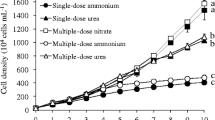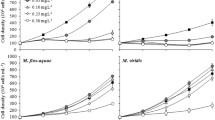Abstract
Blooms of Microcystis aeruginosa frequently occur in many eutrophic lakes in China, however, there is very little experimental study on the relationship between Microcystis and rotifers from Chinese waters. The effects of different concentrations of toxic M. aeruginosa PCC7820 on two common freshwater rotifers Brachionus calyciflorus and B. rubens were investigated in laboratory experiments. B. calyciflorus was able to utilize this strain of M. aeruginosa as a food source. However, M. aeruginosa suppressed the survival and reproduction of B. calyciflorus at the highest concentration (106 cells/ml) probably due to the inadequate nutrition. B. rubens was inhibited by toxic M. aeruginosa PCC7820 and the inhibition increased with the increasing Microcystis concentration. Our study indicates that the two rotifers have different sensitivities to toxic M. aeruginosa and that toxic cyanobacteria may affect zooplankton community structure by differentially inhibiting the different zooplankton taxa.


Similar content being viewed by others
References
Arnold DE (1971) Ingestion, assimilation, survival, and reproduction by Daphnia pulex fed seven species of blue-green algae. Limnol Oceanogr 16:906–920
Chen FZ, Xie P (2003) The effects of fresh and decomposed Microcystis aeruginosa on cladocerans from a subtrophical Chinese lake. J Freshw Ecol 18:97–104
Christoffersen K (1996) Ecological implications of cyanobacteria toxins in aquatic food webs. Phycologia 35:42–50
DeMott WR (1986) The role of taste in food selection by freshwater zooplankton. Oecologia 69:334–340
DeMott WR (1999) Foraging strategies and growth inhibition in five daphnids feeding on mixtures of a toxic cyanobacterium and a green alga. Freshw Biol 42:263–274
DeMott WR, Moxter F (1991) Foraging on cyanobacteria by copepods: responses to chemical defenses and resource abundance. Ecology 72:1820–1834
DeMott WR, Zhang QX, Carmichael WW (1991) Effects of toxic cyanobacteria and purified toxins on the survival and feeding of a copepod and three species of Daphnia. Limnol Oceanogr 36:1346–1357
Doekel S, Marahiel MA (2001) Biosynthesis of natural products on modular peptide synthetases. Metab Eng 3:64–77
Edmondson WT, Litt AH (1982) Daphnia in Lake Washington. Limnol Oceanogr 27:272–293
Fastner J, Flieger I, Neumann U (1998) Optimised extraction of microcystins from field samples—a comparison of different solvents and procedures vol 32. Elsevier Science, pp 3177–3181
Ferräo-Filho AS, Azevedo S, DeMott WR (2000) Effects of toxic and non-toxic cyanobacteria on the life history of trophic and temperate cladocerans. Freshw Biol 45:1–19
Fulton RS III (1988) Grazing on filamentous algae by herbivorous zooplankton. Freshw Biol 20:263–271
Fulton RS III, Jones RC (1991) Growth and reproductive responses of Daphnia to cyanobacterial blooms on the Potomac River. Int Rev Ges Hydrobiol 76:5–19
Fulton RS III, Paerl HW (1987) Toxic and inhibitory effects of the blue-green alga Microcystis aeruginosa on herbivorous zooplankton. J Plankton Res 9:837–855
Geng H, Xie P, Xu J (2006) Effect of Microcystis aeruginosa PCC7820 in combination with a green alga on the experimental population of Brachionus calyciflorus and B. rubens. Bull Environ Contam Toxicol 76:963–969
Ghadouani A, Pinel-Alloul B, Prepas EE (2003) Effects of experimentally induced cyanobacteria blooms on crustacean zooplankton communities. Freshw Biol 48:363–381
Gilbert JJ (1988) Suppression of rotifer population by Daphnia: a review of the evidence, the mechanisms, and the effects on zooplankton community structure. Limnol Oceanogr 33:1286–1303
Gilbert JJ (1990) Different effects of Anabaena affinis on cladocerans and rotifers: mechanisms and implications. Ecology 71:1727–1740
Gilbert JJ (1994) Susceptibility of planktonic rotifers to a toxic strain of Anabaena flos-aquae. Limnol Oceanogr 39:1286–1297
Gilbert JJ, Durand MW (1990) Effect of Anabaena flos-aquae on the abilities of Daphnia and Keratella to feed and reproduce on unicellular algae. Freshw Biol 24:577–596
Hansson LA, Bergman E, Cronberg C (1998) Size structure and succession in phytoplankton communities: the impact of interactions between herbivory and predation. Oikos 81:337–345
Hietala J, Laurén-Maatta C, Walls M (1997) Sensitivity of Daphnia to toxic cyanobacteria: effects of genotype and temperature. Freshw Biol 37:299–306
Hietala J, Reinikainen M, Walls M (1995) Variation in life history responses of Daphnia to toxic Microcystis. J Plankton Res 17:2307–2318
Krebs CJ (1985) Ecology: the experimental analysis of distribution and abundance. Harper and Row, New York, 800 pp
Lampert W (1987) Laboratory studies on zooplankton-cyanobacteria interactions. N Z J Mar Freshwater Res 21:483–490
Lewis WM (1987) Trophical limnology. Annu Rev Ecol Syst 18:159–184
Li S, Zhu H, Xia Y, Yu M, Liu K, Ye Z, Chen Y (1959) The mass culture of unicellular green algae. Acta Hydrobiol Sin 4:462–472 (in Chinese with English abstract)
Lotka AJ (1913) A natural population norm. J Wash Acad Sci 3:241–248
Lürling M (2003) Effects of microcystin-free and microcystin-containing strains of the cyanobacterium Microcystis aeruginosa on growth of the grazer Daphnia magna. Environ Toxicol 18:202–210
Nandini S (2000) Responses of rotifers and cladocerans to Microcystis aeruginosa (Cyanophyceae): a demographic study. Aquatic Ecol 34:227–242
Nandini S, Rao TR (1998) Somatic and population growth in selected cladoceran and rotifer species offered the cyanobacterium Microcystis aeruginosa as food. Aquatic Ecol 31:283–298
Nilssen JP (1984) Tropical lakes—functional ecology and future development: the need for a process oriented approach. Hydrobiologia 113:231–242
Nizan W, Dimentman C, Shilo M (1986) Acute toxic effects of the cyanobacterium Microcystis aeruginosa on Daphnia magna. Limnol Oceanogr 31:497–502
O’Brien WJ (1987) Planktivory by freshwater fish: thrust and parry in the pelagia. In: Kerfoot WC, Sih A (eds) Predation: direct and indirect impacts on aquatic communities. New England, pp 3–16
Poole RW (1974) An introduction to quantitative ecology. McGraw-Hill, New York 532 pp
Reinikainen M, Ketola M, Walls M (1994) Effects of the concentrations of toxic Microcystis aeruginosa and an alternative food on the survival of Daphnia pulex. Limnol Oceanogr 39:424–432
Rohrlack T, Henning M, Kohl JG (1999) Mechanisms of the inhibitory effect of the cyanobacterium Microcystis aeruginosa on Daphnia galeata’s ingestion rate. J Plankton Res 21:1489–1500
Rothhaupt KO (1990) Differences in particle size-dependent feeding efficiencies of closely related rotifer species. Limnol Oceanogr 35:16–23
Rothhaupt KO (1991) The influence of toxic and filamentous blue-green algae on feeding and population growth of the rotifer Brachionus rubens. Int Rev ges Hydrobiol 76:67–72
Smith AD, Gilbert JJ (1995) Relative susceptibilities of rotifers and cladocerans to Microcystis aeruginosa. Arch Hydrobiol 132:309–336
Snell TW, Janssen CR (1995) Rotifers in ecotoxicology: a review. Hydrobiologia 313/314:231–247
Stanier RY, Kunisawa R, Mandel M, Cohenbaz G. (1971) Purification and properties of unicellular blue-green algae (order Chroococcales). Bacteriol Rev 35:171–205
Starkweather PL, Kellar PE (1987) Combined influences of particulate and dissolved factors in the toxicity of Microcystis aeruginosa (NRC-SS-17) to the rotifer Brachionus calyciflorus. Hydrobiologia 147:375–378
USEPA (1985) Methods for measuring the acute toxicity of effluents to freshwater and marine organisms. Peltier WH, Weber CI (eds) EPA/600/485/013, 216 pp. U. S. Environ Protec Agency, Washington DC
Williams WD (1994) Constraints to the conservation and management of tropical inland waters. Mitt Int Ver Limnol 24:357–363
Xie P, Liu JK (2001) Practical success of biomanipulation using filter-feeding fish to control cyanobacteria blooms: a synthesis of decades of research and application in subtropical hypereutrophic lake. Sci World 1:337–356
Yokoyama A, Park H (2002) Mechanism and prediction for contamination of freshwater bivalves (Unionidae) with the cyanobacterial toxin microcystin in hypereutrophic Lake Suwa, Japan. Environ Toxicol 17:424–433
Acknowledgements
We thank Dr. Jun Chen and Mr. Gaodao Liang for kind helps in measuring the microcystin content of Microcystis aeruginosa PCC7820. This work was supported by a fund from the National Natural Science Foundation of China (30530170, 30700088) and by the Nature Science Fund of South-Central University for Nationalities (YZZ07002).
Author information
Authors and Affiliations
Corresponding author
Rights and permissions
About this article
Cite this article
Geng, H., Xie, P. Experimental studies on the effects of toxic Microcystis aeruginosa PCC7820 on the survival and reproduction of two freshwater rotifers Brachionus calyciflorus and Brachionus rubens . Ecotoxicology 17, 709–715 (2008). https://doi.org/10.1007/s10646-008-0219-8
Received:
Accepted:
Published:
Issue Date:
DOI: https://doi.org/10.1007/s10646-008-0219-8




